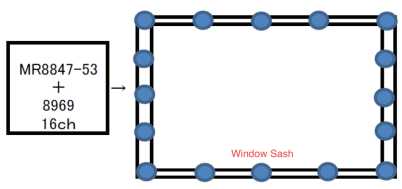Finding the Cause of Creaking Noise from Door Sashes
Aluminum door or window sashes are used extensively in industrial faciliti es due to their light weight, strength, and ease of maintenance. Find out how a sash manufacturer uti lized the Hioki MR8847A and 8969 to troubleshoot creaking noise issues coming from the sash in order to apply the fi ndings to future product improvements and make recommendati ons on how to prevent this issue during installati on.
A window or door sash is the horizontal and vertical frame that holds the glass within, and aluminum sashes are among the most commonly-used sash option in commercial buildings. They are on par with stainless steel or fiberglass-based sashes in terms of resistance against moisture, and most aluminum sashes are finished with an oxidized coating and negates corrosion and pitting or scratching, making them immune to moisture-seepage and neglectful handling. They also have great tensile strength, are easy to install because of their light weight, and are easy to maintain, making them an ideal choice for exterior glass doors at large facilities that have to withstand external weather conditi ons, compared to wooden door sashes that tend to warp due to moisture seepage and metal sashes that are vulnerable to scratches and corrosion.

However, they are not without problems. A commercial customer of a large industrial aluminum sash manufacturer complained of creaking noises when operati ng their large aluminum sliding doors. One reason for the noise can be attributed to some distortion or warp of the aluminum, which can be detected by an acceleration pick up sensor and a memory recorder.
Specifically, the manufacturer went to the customers site with the recorder and attached the sensor at 16 points around the sash equidistant from each other, set the level trigger, and recorded any creaking that occurred at unpredictable ti mes. By plotti ng the signal along a ti me series, the manufacturer was able to identi fy the locati on along the sash from which the creaking occurred, the magnitude of the vibrati on, and even the directi on the noise traveled. They took the data to improve product design as well as provide feedback to the contractors during installati on of the sash.
An MR8847-53 installed with 8 units of 8969 Strain Unit delivers 16 channels of measurement and recording. Because the accelerati on sensors can be directly connected to the Strain Unit, this was an eff ecti ve soluti on that was previously not achievable with the legacy 8841 Memory HiCorder and the standard 8936 Analog Unit, which would require an additi onal external amplifi er to drive the sensors.
The compact MR8847-53 is also designed for field use, making it ideal for on-site applicati ons such as this.


